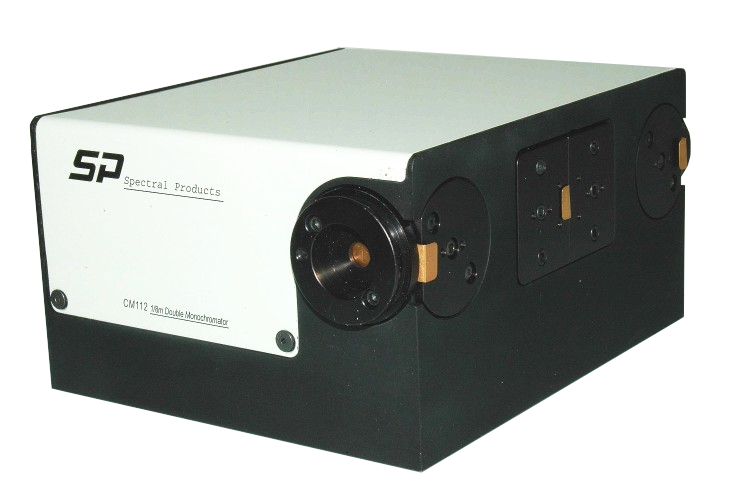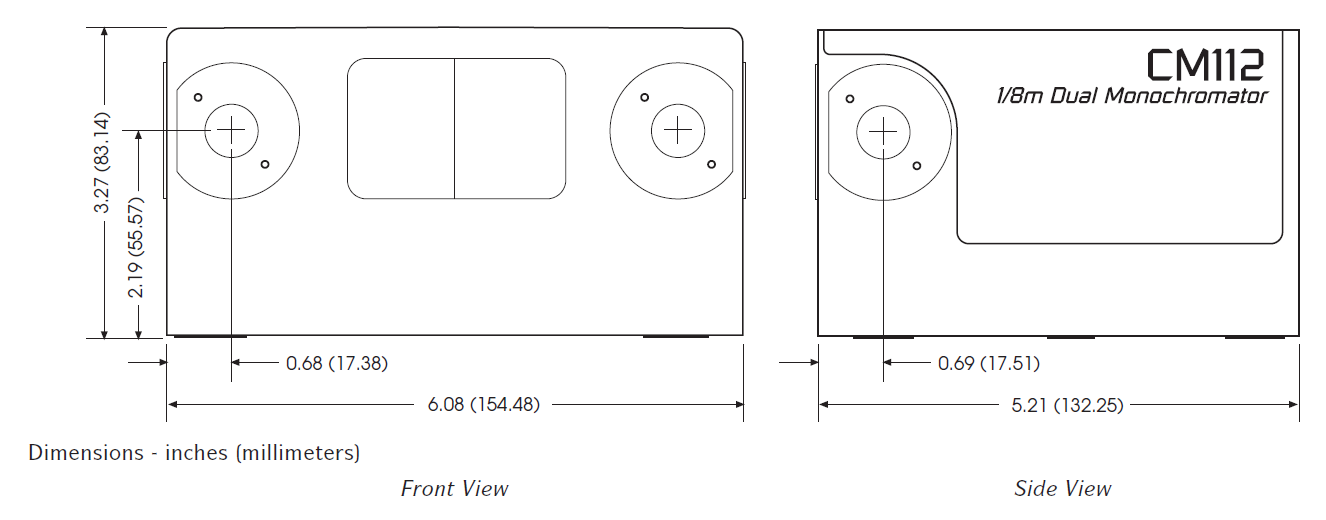The Digikröm CM112: Much More than a Monochromator
- Compact Size: Only 5.25 x 6.25 x 3.25 inches
- Connects to any computer via RS 232
- Scans in both directions. Programmable in Angstrom, nanometers, microns, wavenumbers, or eV.
- Dual double-grating turrets with automatic grating change allows for broad spectral range coverage.
- Subtractive dispersion model minimizes image distortion and pulse spread, with the sub-picosecond residual broadening of regular monochromators.
- Additive mode gives increased dispersion and low stray light for Raman fluorescence studies.
- May be configured as a monochromator or a spectrograph.
- Monochromator may be factory configured for right angle or straight through beam path.
The CM112 is two single monochromators in a series. The exit slit of the first monochromator is the entrance slit of the second. The two monochromators act as a double filter with the rejection of stray light being almost the square of the single monochromator value. The CM112 may be factory configured as an additive or subtractive dispersion double monochromator. As an additive instrument, the first grating spreads the spectrum over an angular range; the second grating then doubles this dispersion. The result is twice the resolution of a single 1/8 meter monochromator. As a subtractive instrument, the first monochromator selects a bandpass, the second monochromator then removes the temporal and angular aberrations introduced by the angular spectral dispersion in the first monochromator. The CM112 offers a solution to practical problems in monochromatic imaging. Selecting a monochromatic image with an ordinary monochromator fails because multiple wavelengths in the bandpass create multiple, overlapping images. In the CM112, the second subtractive monochromator recombines these multiple images, creating a clear image.
Finally, the CM112 is a unique solution to practical problems in the spectroscopy of pulsed sources. An ordinary monochromator has a spread in the internal optical path lengths that will introduce a 25 to 100 picosecond broadening in light pulses that are passed through the monochromator. In the subtractive dispersion CM112, the second monochromator equalizes the optical path lengths so that broadening is reduced to a minimum.
To contact us for more information, please click the "Contact Us" button to go to the Contact Us page. To request a quote or more details about this item, please click the "Email Inquiry" button to open an email to us.
Model |
CM112 |
| Design | Double cascaded Czerny-Turner Double grating turrets standard in each section |
| Focal Length | 110mm each section |
| f/# | 3.9 |
| Beam Path | Straight through standard Right angle provided on request |
| Wavelength Drive | Dual worm and wheel with electronic synchronization and computer control. Programmable in additive or subtractive dispersion with positive or negative gratings orders. |
| Wavelength Precision | 0.1nm (Additive) 0.2nm (Subtractive) |
| Wavelength Accuracy | ± 0.3nm (Additive) ± 0.6nm (Subtractive) |
| Slewing Speed | > 100nm/s |
| Stray Light | <10-9 |
| Slits | Standard set includes: 0.125mm, 0.15mm, 0.3mm, 0.6mm, 1.2mm, and 2.4mm x 4.0mm. For other sizes, please consult SP. |
| Max Resolution | < 0.5nm (Additive) < 1nm (Subtractive) |
| Band Pass | ~1nm (with 1200gv/mm grating and 0.15mm slit) |
| Gratings | 2 or 4 gratings (30 x 30mm) must be purchased See CM gratings options page. |
| Software | Demonstration control program and LabView driver included |
| Power | UL listed 110/220V power pack |
| Interface | RS 232 standard |
| Weight | 2.3 kg |
| Warranty | 1 year |
| Options |
- Handheld control module with function keys and display for local control See accessories for more options |


